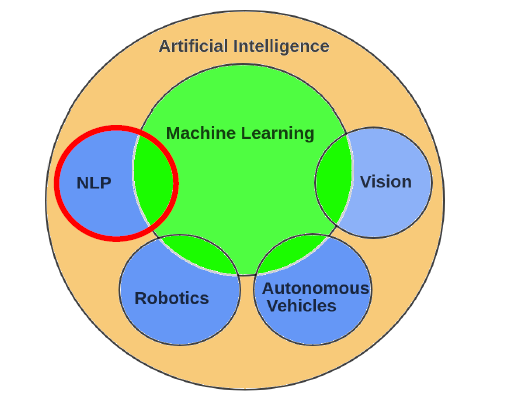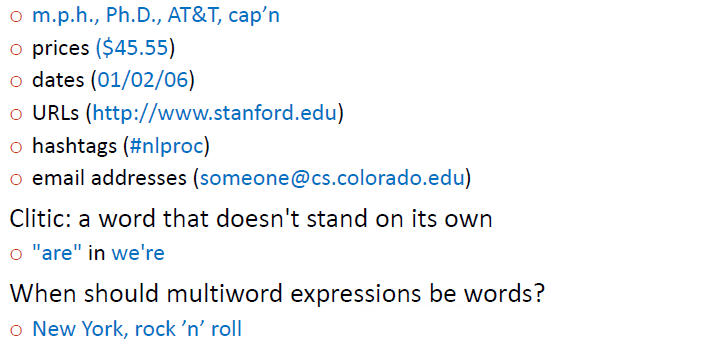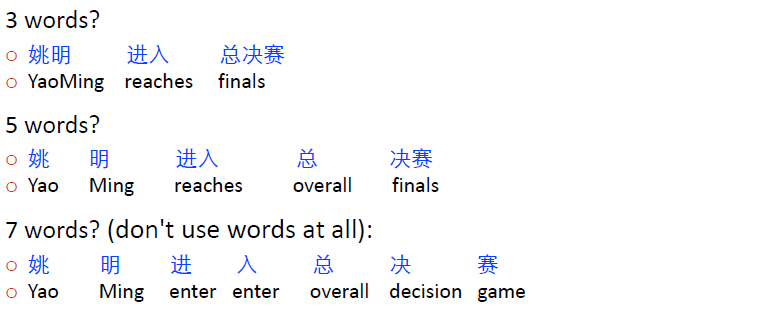(一)Introduction and Tokenization
Introduction
自然语言处理(Natural language processing,NLP)是语言学、计算机科学和人工智能的一个分支领域,研究计算机与人类语言之间的关系、相互作用,特别是如何编程计算机来处理和分析自然语言数据。
目标:使计算机能够理解文本的内容,包括上下文之间的细微差别(contextual nuances)

NLP的一些难题
Difficulty 1: Ambiguty
- Lexical ambiguity:词汇歧义——门把手弄坏了
- Part-of-speech ambiguity:词性歧义——Time flies like an arrow.
- Structural ambiguity:结构歧义——关于鲁迅的文章 。
Difficulty 2: unknown language phenomena
- 新的术语、人名、地名——裸退、非典
- 新的含义——苹果、凡尔赛
- 新的语法——百度一下、Google it
NLP的应用场景
- Information Retrieval:百度、Google、Bing
- Text Generation :九歌——人工智能诗歌写作系统
- Machine Translation:百度翻译、谷歌翻译
- Question Answering & Dialogue Systems:天猫精灵、小度
- Knowledge Graph
- Automatic Summarization
- Sentiment Analysis
- ...
Corpora
corpora语料库,是可以是单个文档或多个文档的集合
一个text是由这些组成的:
- 特定的作者
- 特定的事件
- 特定的类型
- 特定的语言
- 特定的功能
语言不是凭空出现的,所以我们需要语料库来进行学习。
Text Normalization
所有自然语言处理都涉及到文本的规范化:
- Tokenizing words
- Normalizing word formats
- Segmenting sentences
Tokenization
简单的方法:
- 根据space characters来划分
使用Unix/Linux的工具来进行space-based tokenization
1 | |
- 当然,不能仅仅依靠标点符号来划分

- 还有很多语言,比如说中文和日文是不使用空格来分隔单词的,那么又该如何划分呢?

- 使用数据来进行划分
常用算法有:
- Byte Pair Encoding (BPE)
- Unigram language modeling tokenization
- WordPiece (Schuster and Nakajima,
它们都具有两个部分:
- token learner:以一套原始的语料库进行学习并生成一个词汇表
- token segmenter:根据词汇表来对一个测试句子进行划分
BPE token learner
基本步骤:
- 词汇表记录所有的单独的字符
- 循环:
- 选择两个在训练语料库中出现频率最高的相邻符号(say 'A','B')
- 将一个新的'AB'加入词汇表
- 取代所有相邻的'A'和'B'
- 直到有k个合并完成
由于大部分subword算法都是基于空格的划分,所以我们常常先向词汇表加入一个符号'_'
例子




Normalizing word formats
- U.S.A. or USA
- uhhuh or uh-huh
- Fed or fed
- am, is, be, are
Lemmatization:转换为lemma词根
Stemming:将单词后缀删去,化繁为简
小项目
使用python进行网页的爬取、分词、写入excel表格。 URL: https://news.ifeng.com/c/89TNORdIths Crawler: www.topcoder.com/thrive/articles/web crawler in python Chinese word tokenization: https://github.com/fxsjy/jieba
总体来说不算难,根据爬虫和结巴两个包的示范代码,进行稍微的修改就可以实现了。
代码:
1 | |
运行结果:

(一)Introduction and Tokenization
https://wuhlan3.gitee.io/2021/09/20/tokenization/